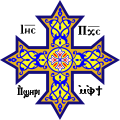External links
- "Athanasius II, Kelitis (490–496)". Official web site of the Greek Orthodox Patriarchate of Alexandria and All Africa. Retrieved 2011-02-07.
- البابا أثناسيوس الثاني [Pope Athanasius II] (in Arabic). Official website of St. Takla Haymanot's Church . Retrieved 2011-02-13.
| Preceded by | Coptic Pope 490–496 | Succeeded by |
| Patriarch of Alexandria 490–496 |
| ||
| 1st–4th centuries Roman Empire (30 BCE – 330 CE) | ||
| 4th–7th centuries Byzantine rule (330–642) | ||
| 7th–10th centuries Sasanian (619–629) Second Byzantine rule (629–642) Muslim conquest (639–642) Rashidun Caliphate (642–658) Umayyad Caliphate (659–750) Abbasid Caliphate (750–969) | ||
| 10th–12th centuries Fatimid Caliphate (969–1171) | ||
| 12th–13th centuries Ayyubid dynasty (1171–1250) | ||
| 13th–16th centuries Mamluk Sultanate (1250–1517) | ||
| 16th–18th centuries Ottoman (1517–1805) | ||
| 18th–20th centuries French Expedition (1798–1801) Muhammad Ali Dynasty(1805–1882) British Occupaction (1882–1922) Kingdom of Egypt (1922–1952) Arab Republic of Egypt (1952–present) | ||
| 21st century |
| |
| International | |
|---|---|
| National | |
| | This article about an Oriental Orthodox clergyman is a stub. You can help Wikipedia by expanding it. |
